|
|
Villager blinded by landmine intended to protect against attack
On March 21, Saw Da Maung Htoo, 22, was searching for vegetables in an area of Toungoo District, northern Karen state where Burma Army troops were patrolling, and where, unknown to him, the local resistance had laid landmines to keep Burma Army troops from reaching a nearby group of Internally Displaced People (IDPs). The landmine exploded in his face, severely injuring his right hand and blinding him.
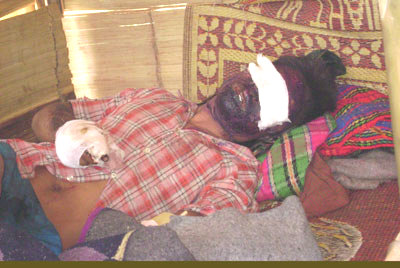 |
| Saw Da Maung Htoo, injured while searching for vegetables. March 21, 2009. |
Some villagers and the resistance groups who try to protect them, resort to the use of home-made landmines in order to guard against attack. The frequency of these attacks, the limited ability of villagers to defend themselves, and the overwhelming firepower of the Burma Army have caused them to adopt this tactic. While these mines are intended to be a defense against attacking Burma Army troops, and are often finite-lifespan mines, made from bamboo, AA batteries, and other easy-to-find materials, they are nonetheless destructive when triggered. Despite efforts of the resistance to inform all locals of areas that are off-limits because of mines, villagers often live in remote locations and information is sometimes slow to arrive. People must also search wide areas of land to find sufficient food, and during this movement they sometimes fall victim to mines laid by the resistance or other villagers.
 |
| Map of areas covered in report |
The Burma Army has continued its campaign of violence and extortion against villagers in northern Karen State over the last several months. Burma Army troops conduct regular patrols and sweeps through the jungle in an attempt to locate and terrorize pockets of displaced Karen villagers. While these attacks have not developed into large-scale, coordinated attacks this year, the patrols are no less terrifying for those villagers being threatened. Since October 2008, at least five villagers have been shot and killed or died from Burma Army landmines in the northern three districts of Karen State alone. In addition, more than 2,600 people have been forced to flee their homes during the same period.
Burma Army captures four villagers in Nyaunglebin District
On 5 March, 2009, Light Infantry Battalion (LIB) 590 deputy battalion commander Zaw Moo Wein reinforced his troops with elements of LIB 599, entered Aung Char Tha village and captured one villager. On the same day, another villager was captured from Paw Pi Der village and taken to the battalion’s headquarters. On March 7 the Burma Army captured U Kyein Lwein with another man from Wei La Daw village and sent them to Ye O Sin camp. It has not yet been reported whether these men have been released.
Villagers face illness as a result of displacement
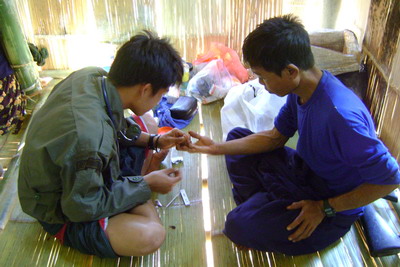 |
| Relief team medic treats malaria patient in Nyaunglebin District. |
Villagers in hiding from Burma Army attacks in northwest Karen State are facing severe health issues as a result of the poverty, instability, and exposure to the elements that have resulted from repeated Burma Army attacks. According to a relief team which recently completed a mission to areas of Nyaunglebin District, diarrhea, along with vomiting, is now commonplace in many areas.
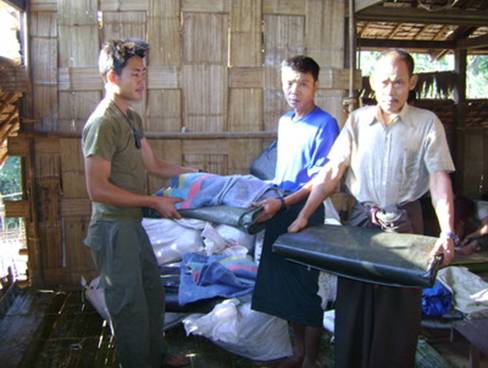 |
| FBR distributes tarpaulins to villagers in Mone Township |
The team recently completed their ten-day mission in Mone Township, Nyaunglebin District, during which time they treated 91 patients and gave out blankets, tarpaulins and other supplies to villagers hiding in the jungles.
Extortion and forced labor in western Karen State
The Burma Army’s use of extortion and forced labor is widespread throughout Burma, and is especially common in areas considered “brown areas”, where the Burma Army has significant control, but resistance groups still have some ability to operate. For example, on March 12 the Burma Army demanded three bullock carts from each of the villages of Aung Char Tha, Metetaw, Hti To Lo, Pau Pi Der, Myaw Oo and sent them to Ye O Sin camp.
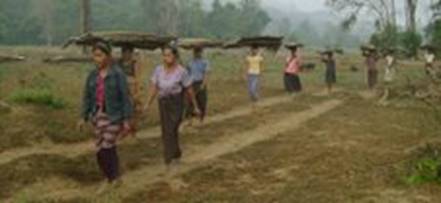 |
| Noh Beah Baw villagers carrying out forced labor for Yo Klar Burma Army Camp |
Villagers are also routinely forced to construct or rebuild car roads, build or fence Burma Army camps with materials they themselves have supplied, transport goods between Burma Army camps and provide roofing materials. This forces some to flee to the mountainous areas of the district where they suffer from chronic illnesses often due to malnutrition.
In January this year, Kyun Bin Seik camp commander Kyaw Thi Ha demanded 750,000 kyats (approximately US$600) from the 150 villagers living in Koni village-tracts who sleep at their farms during the growing season. He also demanded 300-500 kyats (approximately US$0.30) each time villagers travel to pass their camp. The villagers also have to support the Burma Army with food on demand.
FBR has also been informed that the Democratic Karen Buddhist Army (DKBA) is demanding payment of 500 roofing strips from every village in Pa’an Township, central Karen State.
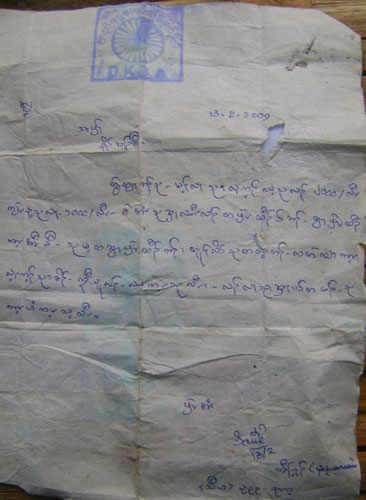 |
| Letter from the DKBA to villagers in Pa’an Township |
The DKBA, a group which joined with the Burma Army in 1994, has reportedly written a letter to each of the more than 100 villages in the township area. The letter demands that every village gives 500 strips of leaves woven into panels to make roofs for DKBA houses.
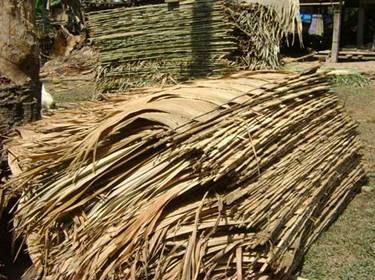 |
| Stacks of thatch like that demanded from villagers by the DKBA |
FBR teams have so far confirmed that 48 villages have received these letters. If they are unable to fulfill the demand, they have to pay a fine of 7,000 kyats (approximately US$5.50) per one hundred roofing strips. The head of each village has been instructed to collect the materials or the money and hand them over to the DKBA central headquarters in Khaw Taw (Myaing Gyi Ngu in Burmese).
The Burma Army, in alliance with the DKBA, controls most of Pa’an District area, meaning they can extort from villagers at will.
Interview of prisoner porter who escaped from the Burma Army in Nyaunglebin District.
Aung Maung Win*name changed, 29, a Buddhist Burman from Xx Xxx Xxx town in Pegu Division (the region west of Karen state), was a bicycle taxi driver. He was twice suspected of theft by his village headman and put in prison. He was then taken from Pegu prison by the Burmese police and sent to Insein prison, and then on to Nyaunglebin prison. From there, he was taken by the Burma Army to be a porter. He was forced to carry heavy loads for them for two months and faced mistreatment from the Military Operation Command (MOC) 1, Light Infantry Battalion 502 commander Kyaw Zwa Min and sergeant Thein Soe Lwin. He carried a load from Bawgata to Rokasoe camp in Ler Doh Township, Nyaunglebin District, in northwest Karen State.
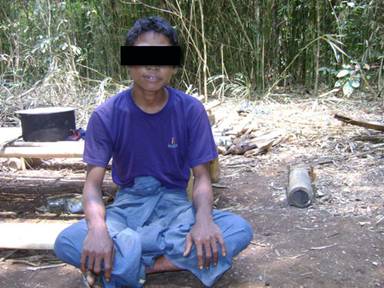 |
| Aung Maung Win, a porter who escaped from the Burma Army |
He said, “The load I carried was ammunition and rice and it weighed about 20 viss (32 kilos) and when I could not keep walking the two commanders would hit me with bamboo on my back, thigh, and calf. Therefore I could not bear it any longer, so I ran from them. Before I ran, LIB 505 replaced the LIB 502 at Rokasoe camp. I started to run from the BA LIB 505 in February 2009 and it took nine days before the Karen soldiers found me in jungle. So for nine days I had no food to eat and I almost died, but the Karen soldiers saw me and fed me well.”
Pictures of Relief
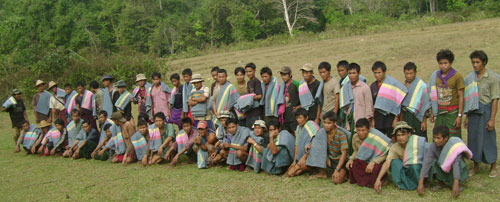 |
| Villagers who helped carry relief supplies are given blankets. |
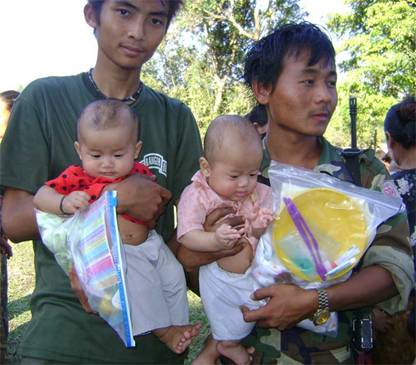 |
| Two FBR medics carry four month old twins. |
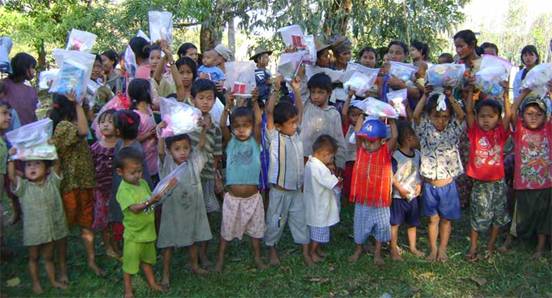 |
| Children from Nawkatao and Treawah villages show off their care packs from FBR |
Thank you and God bless you,
Free Burma Rangers

